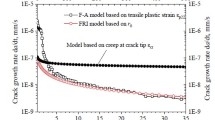Stress corrosion cracking (SCC) is a failure mode determining the safety of dissimilar metal welded joints in nuclear power plants. It is also of great importance to establish an SCC crack propagation life prediction model for the safety of welded joints of practical engineering significance in nuclear power structural safety assessment. The creep constitutive mechanism of 304 stainless steel at 288°C was obtained in the autoclave creep experiment, and the finite element calculation method of SCC based on creep was set up. The creep field around the crack tip and the crack growth rate variation at different yield strength and stress intensity factor K were analyzed. The crack growth rate will increase with the latter characteristics. By comparing with the SCC experimental data, the prediction model accuracy was verified. The results provide a scientific basis for the prediction of the SCC rate of 304 stainless steel in the high-temperature water environment.











Similar content being viewed by others
References
J. L. Zhang, Y. H. Cui, H. Xue, et al., “Research on crack growth behavior of nickel-based alloy 600 in safe-end welded joints,” Rare Metal Mat. Eng., 49, No. 5, 1496–1502 (2020).
C. Ma, Q. J. Peng, E. H. Han, et al., “Review of stress corrosion cracking of structural materials in nuclear power plants,” Journal of Chinese Society for Corrosion and Protection, 34, No. 1, 37–45 (2014).
F. Q. Yang, H. Xue, L. Y. Zhao, and X. R. Fang, “A quantitative prediction model of SCC rate for nuclear structure materials in high-temperature water based on crack tip creep strain rate,” Nucl. Eng. Des., 278, No. 8, 686–692 (2014).
F. P. Ford and P. L. Andresen, “Development and use of a predictive model of crack propagation in 304/316L, A533B/A508 and Inconel 600/182 alloys in 288°C water,” in: Proc. of the Third Int. Symp. on Environmental Degradation of Materials in Nuclear Power Systems (1988), pp. 789–800.
T. Shoji, Z. Lu, and H. Murakami, “Formulating stress corrosion cracking growth rates by combination of crack tip mechanics and crack tip oxidation kinetics,” Corros. Sci., 52, No. 3, 769–779 (2010).
M. M. Hall, Jr, “Critique of the Ford–Andresen film rupture model for aqueous stress corrosion cracking,” Corros. Sci., 51, No. 5, 1103–1106 (2009).
H. Xue and T. Shoji, “Quantitative prediction of EAC crack growth rate of sensitized type 304 stainless steel in boiling water reactor environments based on EPFEM,” J. Press. Vess.-T. ASME, 129, No. 3, 460–467 (2007).
M. M. Hall, Jr, “Film rupture model for aqueous stress corrosion cracking under constant and variable stress intensity factor,” Corros. Sci., 51, No. 2, 225–233 (2009).
L. Zhang, K. Chen, D. Du, et al., “Characterizing the effect of creep on stress corrosion cracking of cold worked Alloy 690 in supercritical water environment,” J. Nucl. Mater., 492, 32–40 (2017).
K. Chen, D. Du, W. Gao, et al., “Effect of cold work on the stress corrosion cracking behavior of Alloy 690 in supercritical water environment,” J. Nucl. Mater., 498, 117–128 (2018).
S. Maharjan, X. C. Zhang, F. Z. Xuan, et al., “Residual stresses within oxide layers due to lateral growth strain and creep strain: Analytical modeling,” J. Appl. Phys., 110, No. 6, 063511 (2011).
D. Du, K. Chen, L. Yu, et al., “SCC crack growth rate of cold worked 316L stainless steel in PWR environment,” J. Nucl. Mater., 456, 228–234 (2015).
H. Xue, Y. Sato, and T. Shoji, “Quantitative estimation of the growth of environmentally assisted cracks at flaws in light water reactor components,” J. Press. Vess.-T. ASME, 131, No. 1, 011404 (2009).
Y. Yi and G. S. Was, “Stress and temperature dependence of creep in Alloy 600 in primary water,” Metall. Mater. Trans. A, 32, No. 10, 2553–2560 (2001).
Y. Xue, Research on Structure and Properties of Duplex Stainless Steel for Nuclear Power Plant Pipes, Xi’an Technological University (2010).
L. Dong, Q. Peng, E. H. Han, et al., “Microstructure and intergranular stress corrosion cracking susceptibility of a SA508-52M-316L dissimilar metal weld joint in primary water,” J. Mater. Sci. Technol., 34, No. 8, 1281–1292 (2018).
ASTM D5045-99(2007)e1, Standard Test Methods for Plane-Strain Fracture Toughness and Strain Energy Release Rate of Plastic Materials, ASTM International, West Conshohocken, PA (2007).
W. Ramberg and W. R. Osgood, Description of Stress–Strain Curves by Three Parameters, Technical Note No. 902 (1943).
J. S. Ma, Finite Element Analysis of 3D Mixed-Mode Fracture Stress Intensity Factors [in Chinese], Harbin Engineering University (2008).
Y. H. Cui, J. L. Zhang, and X. L. Li, “Influence of yield stress on the SCC creep mechanical field and growth rate at the tip of 304 stainless steel,” Foundry Technol., 41, No. 12, 1117–1121 (2020).
K. Arioka, T. Yamada, T. Terachi, et al., “Cold work and temperature dependence of stress corrosion crack growth of austenitic stainless steels in hydrogenated and oxygenated high temperature water,” Corrosion, 63, No. 12, 1114–1123 (2007).
O. K. Chopra and A. S. Rao, “A review of irradiation effects on LWR core internal materials IASCC susceptibility and crack growth rates of austenitic stainless steels,” J. Nucl. Mater., 409, No. 3, 235–256 (2011).
Acknowledgments
This work was financially supported by the Natural Science Foundation of China
(51475362), and Key Scientific and Technological Projects in Henan Province of China (202102210068).
Author information
Authors and Affiliations
Corresponding author
Additional information
Translated from Problemy Prochnosti, No. 4, pp. 51 – 59, July – August, 2021.
Rights and permissions
About this article
Cite this article
Cui, Y.H., Zhang, J.L. Research of SCC Prediction Model for 304 Stainless Steel in the High-Temperature Water Environment. Strength Mater 53, 573–581 (2021). https://doi.org/10.1007/s11223-021-00319-6
Received:
Published:
Issue Date:
DOI: https://doi.org/10.1007/s11223-021-00319-6




